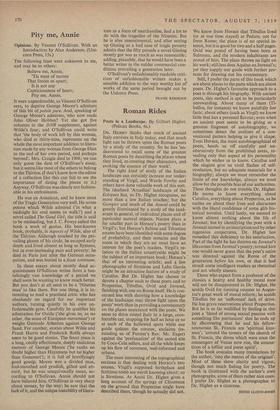Roman Rides
Poets in a Landscape. By Gilbert Highet. (Pelican Books, Gs.) Poets in a Landscape. By Gilbert Highet. (Pelican Books, Gs.)
DR. HIGHET thinks that much of ancient Italy survives in Italy today, and that much light can be thrown upon the Roman poets by a study of the country. So he has 'en- deavoured to recall some of the greatest Roman poets by describing the places where they lived, re-creating their characters, and evoking the essence of their work'.
The right kind of study of the Italian landscape can certainly increase our under- standing of Virgil, and Warde Fowler and others have done valuable work of this sort. The idealised 'Arcadian' landscape of the Eclogues has, as Dr. Highet recognises, no more than a few Italian touches; but the Georgics and much of the Aeneid could be greatly illuminated by a study of the land- scape in general, of individual places and of particular natural objects. Nature plays a far smaller part in Horace's poetry than in Virgil's; but Horace's Sabine and Tiburtine estates have been identified with some degree of probability, and their remains and the scene in which they are set must have an interest for the poet's readers. Virgil's re- lation to the Italian countryside might be the subject of an important book; Horace's that of an interesting article; and a few photographs of Sirmione and Lake Garda might be an attractive feature of a study of Catullus. But Dr. Highet has chosen to devote a chapter each to these poets and to Propertius, Tibullus, Ovid and Juvenal, finishing with one on Rome itself. He is con- cerned less with showing how a knowledge of the landscape may throw light upon the poets' work than in providing a commentary on the places associated with the poets. We seem to drive round Italy in a large, com- fortable car, stopping for half an hour or so at each of the hallowed spots while our guide quizzes the curator, exclaims (re- minding us of Forster's Rev. Mr. Eager) against the 'profanation' of the sacred site by Coca-Cola sellers, and all the while keeps up his flow of comment, well-informed and urbane.
The most interesting of the topographical sections is that dealing with Horace's two estates. Virgil's supposed birthplace and fictitious tomb are worth knowing about; so is Sirmione. At Assisi Dr. Highet gives a long account of the springs of Clitumnus on the ground that Propertius might have described them, though he actually did not. We know from Horace that Tibullus lived (or at one time stayed) at Pedum, not far from Rome; the place is of no special in- terest, but it is good for two and a half pages. Ovid was proud of having been born at Sulmona, and the modern inhabitants are proud of him. The place throws no light on his work; still less does Aquino on Juvenal's; yet they supply our guide with further pre- texts for drawing out his commentary.
Still, I prefer the parts of this book which are about places to the parts which are about poets. Dr. Highet's favourite approach to a poet is through his biography. With ancient poets, this method is apt to be particularly unrewarding. About many of them (Ti- bullus, for instance) we know painfully few facts; about others (such as Virgil) we know little that has a personal flavour; even when an ancient poet seems to be giving us a genuine fragment of autobiography, we sometimes detect the outlines of a con- ventional pattern helping to give it shape. Even Horace, the most autobiographical of poets, heads us off carefully and un- obtrusively from the prohibited areas, re- vealing only that aspect of his personality which he wishes us to know. Catullus and the elegists give us vivid flashes of self- revelation, but no adequate materials for a biography; always we must remember the limits of our knowledge, always we must allow for the possible bias of our authorities. These thoughts do not trouble Dr. Highet. He seems to know everything about Catullus, everything about Propertius, as he rattles on about their lives and characters with the bland confidence of some glib his- torical novelist. Until lately, we seemed to know almost nothing about the life of Juvenal; but by identifying the poet with a Juvenal named in an inscriptionand by other ingenious conjectures, Dr. Highet has remedied this deficiency to his satisfaction. Part of the light he has thrown on Juvenal's life comes from Juvenal's poetry ; to read him one would never guess that the poet's satire was directed against the Rome of the generation before his own, or that it had struck some intelligent readers as rhetorical and not wholly sincere.
Those who expect from a professor of the classics a hearty and healthy moral tone will not be disappointed in Dr. Highet. He scolds Ovid for running counter to Augus- tus's great work of moral reform; he scolds Tibullus for an 'unRoman' lack of drive. He has grave reservations about Propertius. But he is so far mollified by finding in this poet a 'blend of strong sexual passion with something like puritanism' that he ends up by discovering that he and , his fellow- townsman St. Francis are 'spiritual kins- men'; 'around the towers of the church of St. Francis, the doves which were once the messengers of Venus now rise, the emana- tions of a loftier and purer spirit'.
The book contains many translations by the author, 'into the metres of the original'.
Most of these show clarity and vigour, though not much feeling for poetry. The book is illustrated with the author's own photographs, some of them rather nice ones. I prefer Dr. Highet as a photographer to Dr. Highet as a cicerone.
HUGH LLOYD-JONES


























 Previous page
Previous page